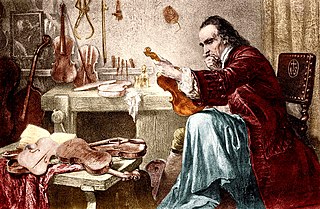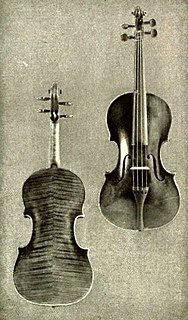
Antonio Stradivari was an Italian luthier and a craftsman of string instruments such as violins, cellos, guitars, violas and harps. The Latinized form of his surname, Stradivarius, as well as the colloquial Strad are terms often used to refer to his instruments. It is estimated that Stradivari produced 1,116 instruments, of which 960 were violins. Around 650 instruments survived, including 450 to 512 violins.

A Stradivarius is one of the violins, violas, cellos and other string instruments built by members of the Italian family Stradivari, particularly Antonio Stradivari, during the 17th and 18th centuries. According to their reputation, the quality of their sound has defied attempts to explain or equal it, though this belief is disputed. The fame of Stradivarius instruments is widespread, appearing in numerous works of fiction.

Carlo Bergonzi was an Italian luthier and is the first and most noted member of the Bergonzi family, an illustrious group of luthiers from Cremona, Italy, a city with a rich tradition of stringed instrument makers. Today his instruments are highly valued for their workmanship and tone. Although he was historically assumed to have first apprenticed with Hieronymus Amati or Antonio Stradivari, he is now known to have been the student of Vincenzo Rugeri.

The Lipinski Stradivarius is an antique violin constructed in 1715 by the Italian luthier Antonio Stradivari of Cremona, during Stradivari's "golden period" between 1700 and 1725. There are fewer than 650 extant Stradivarius violins in the world today, and the Lipinski is considered to be a particularly fine example. In 2012, it was appraised at US$5 million.
The Viotti; ex-Bruce Stradivarius of 1709 is an antique violin constructed by luthier Antonio Stradivari of Cremona (1644–1737). It is one of only 700 known extant Stradivari instruments.
The Messiah - Salabue Stradivarius of 1716 is a violin made by the Italian luthier Antonio Stradivari of Cremona. It is considered to be the only Stradivarius in existence in as new state. It is in the collection of the Ashmolean Museum in Oxford, England.

The Royal Academy of Music Museum is a museum of musical instruments and artefacts and research centre of the Royal Academy of Music in London.
The Alard–Baron Knoop Stradivarius of 1715 is an antique violin made by luthier Antonio Stradivari of Cremona (1644-1737). It was made during Stradivari's golden period and is regarded as the "finest of the fine," and nec plus ultra by the W.E. Hill & Sons. The Alard has the original neck with the initials "PS" found in the mortise of the head believed to be those of son, Paolo Stradivari. The Hill brothers conclude this violin is one of the instruments that came into Paolo's possession upon the death of his brother Francesco in 1742.
W. E. Hill & Sons (1880) is a London-based firm that specialises in violins and other string instruments, and bows. It was also known as William Ebsworth Hill & Sons or William E. Hill & Sons.

Leandro Bisiach was an Italian violin maker, who was born in Casale Monferrato and died in 1945 at Venegono Superiore near Varese.
The Hellier Stradivarius of circa 1679 is a violin made by Antonio Stradivari of Cremona, Italy. It derives its name from the Hellier family, who might well have bought it directly from the luthier himself.
The Baron Knoop, ex-Bevan Stradivarius is a violin made by the celebrated luthier Antonio Stradivari in Cremona, Italy in 1715.

David Laurie - was a distinguished 19th century violin collector.

Hottinger Collection - formed in New York City by Henry Hottinger.
Arthur Edward Smith, known as A. E. Smith, was an English-born Australian violin and viola maker whose violins and violas are prized for their 'excellence of tone' and 'decorative elements'. According to some musicians, "it is his violas that have the greatest reputation, being easily counted amongst the greatest ever created, regardless of era or nationality."

Nicola Amati, Nicolò Amati or Nicolao Amati was an Italian Master Luthier from Cremona, Italy. Amati is one of the most well known luthier from the Casa Amati. Nicola was the teacher of illustrious Cremonese School luthiers such as Andrea Guarneri and Giovanni Battista Rogeri. While no clear documentation exists for being apprentices in his shop, Amati may have also apprenticed Antonio Stradivari, Francesco Rugeri, and Jacob Stainer as their work is heavily influenced by Amati.
The Molitor Stradivarius is an antique violin made by Italian luthier Antonio Stradivari of Cremona in 1697, the very beginning of the maker's celebrated "Golden" period. It bears the label "Antonius Stradivarius Cremonensis / Faciebat Anno 1697" and is branded to the lower rib, "Curtis Phila."

The Violin Museum is a musical instrument museum located in Cremona. The museum is best known for its collection of stringed instruments that includes violins, violas, cellos and double basses crafted by renowned luthiers, including Antonio Stradivari and Giuseppe Guarneri del Gesù.

Vincenzo Rugeri, was an Italian luthier of string instruments such as violins, cellos, and, violas in Cremona, Italy. His instruments are noted for their craftsmanship and tone quality. Vincenzo came from a distinguished family of luthiers, the first of whom was his father, Francesco Rugeri. Despite the local tradition of artisan families laboring together through generations, Vincenzo left the family shop and set up a successful shop of his own in the center of Cremona. Vincenzo was the third son of luthier Francesco Rugeri. Vincenzo's work, like Francesco's, is influenced by Nicolò Amati's Grand Pattern model, however Vincenzo's work was distinguished from his father's by utilizing a lower arch inspired by Antonio Stradivari. An analysis of the body of his work reveals that the quality of Vincenzo's instruments is remarkable, perhaps even more so than his father's. Vincenzo's instruments, though less numerous, are valued at least equal to those of his father. A violin by Vincenzo Rugeri realized $502,320 on October 3, 2011 at Brompton's Auctions in London. Carlo Bergonzi was a distinguished apprentice of Vincenzo Rugeri.










